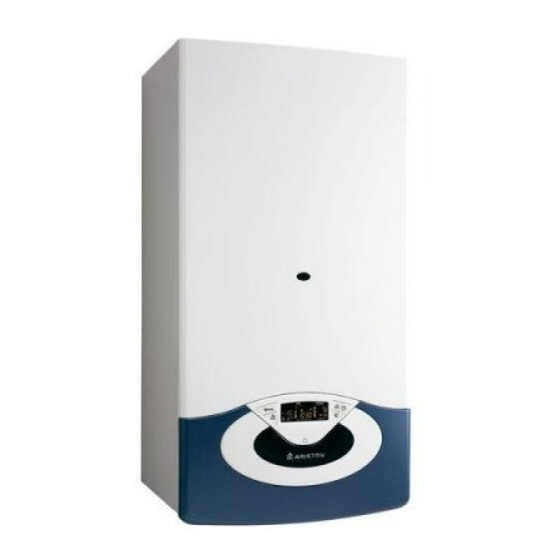Ariston GENUS 24 FF 설치 및 서비스 지침 - 페이지 41
{카테고리_이름} Ariston GENUS 24 FF에 대한 설치 및 서비스 지침을 온라인으로 검색하거나 PDF를 다운로드하세요. Ariston GENUS 24 FF 44 페이지. Wall-hung gas boiler
Ariston GENUS 24 FF에 대해서도 마찬가지입니다: 사용자 설명서 (21 페이지)

- sicurezza temperatura limite.
9. Verifi ca del funzionamento dei sistemi di sicurezza parte gas:
- sicurezza mancanza gas o fi amma (ionizzazione).
10.Controllo dell'effi cienza della produzione di acqua sanitaria
(verifi ca della portata e della temperatura).
11.Controllo generale del funzionamento dell'apparecchio.
12.Rimozione dell'ossido dall'elettrodo di rilevazione tramite tela
smeriglio.
Prova di funzionamento
Dopo aver eff ettuato le operazioni di manutenzione, riempire il
circuito di riscaldamento alla pressione di circa 1,0 bar e sfi atare
l'impianto.
Riempire anche l'impianto sanitario.
- Mettere in funzione l'apparecchio.
- Se è necessario sfi atare nuovamente l'impianto di riscaldamento.
- Verifi care le impostazioni e il buon funzionamento di tutti gli
organi di comando, regolazione e controllo.
- Verifi care la tenuta e il buon funzionamento dell'impianto di
evecuazione fumi/prelievo aria comburente.
Operazioni di svuotamento
Lo svuotamento dell'impianto di riscaldamento deve essere eseguito
nel seguente modo:
- spegnere la caldaia e portare l'interruttore bipolare esterno in
posizione OFF e chiudere il rubinetto del gas;
- allentare la valvola automatica di sfogo aria;
- aprire il rubinetto di scarico dell'impianto raccogliendo in un
contenitore l'acqua che fuoriesce;
- svuotare dai punti più bassi dell'impianto (dove previsti).
Se si prevede di tenere l'impianto fermo nelle zone dove la temperatura
ambiente può scendere nel periodo invernale al di sotto dello 0°C,
si consiglia di aggiungere liquido antigelo all'acqua dell'impianto di
riscaldamento per evitare ripetuti svuotamenti; in caso di impiego di
tale liquido, verifi carne attentamente la compatibilità con l'acciaio
inox costituente il corpo caldaia.
Si suggerisce l'impiego di prodotti antigelo contenenti GLICOLE
di tipo PROPILENICO inibito alla corrosione (come ad esempio il
CILLICHEMIE CILLIT CC 45, il quale è atossico e svolge una funzione
contemporanea di antigelo, antincrostante ed anticorrosione) nelle
dosi prescritte dal produttore, in funzione della temperatura minima
prevista.
Controllare periodicamente il pH della miscela acqua-antigelo del
circuito caldaia e sostituirla quando il valore misurato è inferiore al
limite prescritto dal produttore dell'antigelo.
NON MESCOLARE TIPI DIFFERENTI DI ANTIGELO.
Il costruttore non risponde dei danni causati all'apparecchio o
all'impianto dovuti all'utilizzo di sostanze antigelo o additivi non
appropriati.
Svuotamento impianto sanitario
Ogni qualvolta esista pericolo di gelo, deve essere svuotato l'impianto
sanitario nel seguente modo:
- chiudere il rubinetto della rete idrica;
- aprire tutti i rubinetti dell'acqua calda e fredda;
- svuotare dai punti più bassi (dove previsti).
Posizionamento elettrodi
manutenzione
7.
8.
9.
10. Check the effi ciency of the domestic hot water production
11. Perform a general inspection of the boiler operation.
12. Remove oxide from the detection electrode using an emery
Operational test
After having carried out the maintenance operations, fi ll the heating
circuit at a pressure of approximately 1.0 bar and release the air from
the system.
Fill the domestic hot water system at the same time.
- Begin operating the boiler.
- If necessary, release the air from the heating system again.
- Check the settings and make sure all the command, adjustment
and monitoring parts are working correctly.
- Check the seal and that the system for the expulsion of fumes/
suction of comburent air is operating correctly.
Draining procedures
The heating system must be drained using the following procedure:
- Switch off the boiler, make sure the external bipolar switch is in the
OFF position and shut off the gas valve;
- Loosen the automatic air relief valve;
- Open the system discharge valve and collect the escaping water in
a container;
- Empty the water from the lowest points of the system (where
applicable).
If the system is to be left inactive in areas where the room temperature
may fall below 0°C during winter, we recommend that anti-freeze
liquid is added to the water in the heating system in order to avoid
the need for repeated draining; when this liquid is used make sure it
is compatible with the stainless steel used for the bodywork of the
boiler.
We recommend the use of anti-freeze products which contain
PROPYLENE GLYCOLS as these inhibit corrosion and that they are
used in conjunction with the anti-scaling and anti-corrosion function,
in the quantities suggested by the manufacturer, at the mimimum
temperature.
Regularly check the pH level of the water/anti-freeze mix in the boiler
circuit and replace it when the value measured is lower than the limit
prescribed by the manufacturer.
DO NOT MIX DIFFERENT TYPES OF ANTI-FREEZE.
The manufacturer will not be held liable for any damage caused by
the appliance or the system due to the use of inappropriate anti-
freeze substances or additives.
Draining the domestic hot water system
Every time there is a danger of freezing, the domestic hot water
system must be drained as follows:
- Shut off the water mains inlet valve;
- Open all the hot and cold water taps;
- Empty the water from the lowest points of the system (where
applicable).
Electrodes position
Cleaning the primary heat exchanger
Make sure the following heating safety devices are operating
correctly:
- temperature limit safety device.
Make sure that the following gas part safety devices are operating
correctly:
- absence of gas or fl ame safety device (ionisation).
process (test the fl ow rate and temperature).
cloth.
maintenance
41
